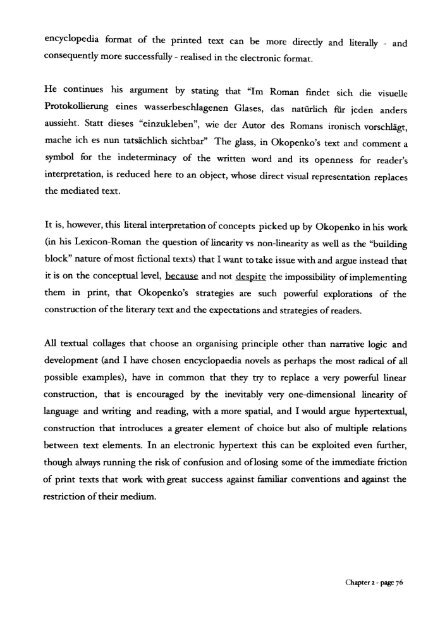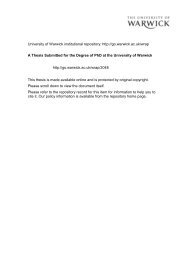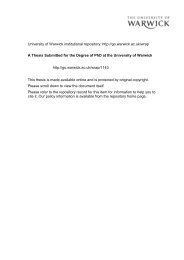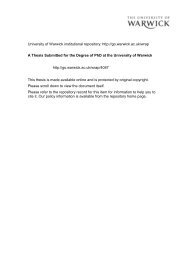From Page to Screen - WRAP: Warwick Research Archive Portal ...
From Page to Screen - WRAP: Warwick Research Archive Portal ...
From Page to Screen - WRAP: Warwick Research Archive Portal ...
Create successful ePaper yourself
Turn your PDF publications into a flip-book with our unique Google optimized e-Paper software.
encyclopedia format of the printed text can be more directly and literally - and<br />
consequently more successfully - realised in the electronic format.<br />
He continues his argument by stating that "Im Roman findet sich die visuelle<br />
Pro<strong>to</strong>kollierung eines wasserbeschlagenen Glases, das natiirlich fiir jeden anders<br />
aussieht. Statt dieses "einzukleben", wie der Au<strong>to</strong>r des Romans ironisch vorschlagt,<br />
mache ich es nun tatsachlich sichtbar" The glass, in Okopenko's text and comment a<br />
symbol for the indeterminacy of the written word and its openness for reader's<br />
interpretation, is reduced here <strong>to</strong> an object, whose direct visual representation replaces<br />
the mediated text.<br />
It is, however, this literal interpretation ofconcepts picked up by Okopenko in his work<br />
(in his Lexicon-Roman the question oflinearity vs non-linearity as well as the "building<br />
block" nature ofmost fictional texts) that I want <strong>to</strong> take issue with and argue instead that<br />
it is on the conceptual level, because and not despite the impossibility ofimplementing<br />
them in print, that Okopenko's strategies are such powerful explorations of the<br />
construction ofthe literary text and the expectations and strategies ofreaders.<br />
All textual collages that choose an organising principle other than narrative logic and<br />
development (and I have chosen encyclopaedia novels as perhaps the most radical of all<br />
possible examples), have in common that they try <strong>to</strong> replace a very powerful linear<br />
construction, that is encouraged by the inevitably very one-dimensional linearity of<br />
language and writing and reading, with a more spatial, and I would argue hypertextual,<br />
construction that introduces a greater element of choice but also of multiple relations<br />
between text elements. In an electronic hypertext this can be exploited even further,<br />
though always running the risk of confusion and oflosing some ofthe immediate friction<br />
of print texts that work with great success against familiar conventions and against the<br />
restriction oftheir medium.<br />
Chapter 2 - page 76





